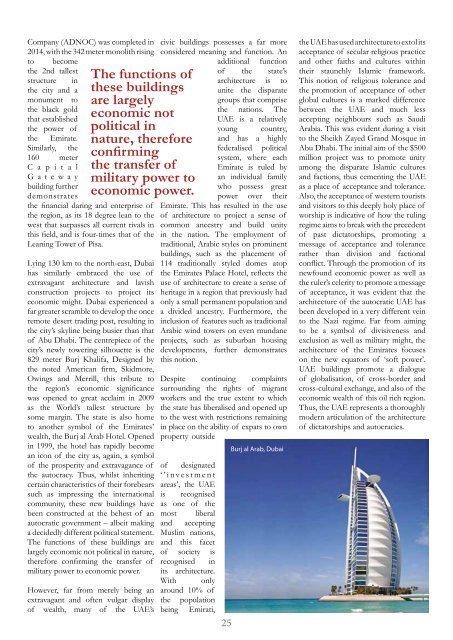Ink 2017
Ink is the School's academic magazine. Published annually, it is an outlet for both academic and creative writing, featuring contributions from Senior School students and members of staff.
Ink is the School's academic magazine. Published annually, it is an outlet for both academic and creative writing, featuring contributions from Senior School students and members of staff.
Create successful ePaper yourself
Turn your PDF publications into a flip-book with our unique Google optimized e-Paper software.
Company (ADNOC) was completed in<br />
2014, with the 342 meter monolith rising<br />
to become<br />
the 2nd tallest<br />
structure in<br />
the city and a<br />
monument to<br />
the black gold<br />
that established<br />
the power of<br />
The functions of<br />
these buildings<br />
are largely<br />
economic not<br />
political in<br />
nature, therefore<br />
confirming<br />
the transfer of<br />
military power to<br />
economic power.<br />
the Emirate.<br />
Similarly, the<br />
160 meter<br />
C a p i t a l<br />
Gateway<br />
building further<br />
demonstrates<br />
the financial daring and enterprise of<br />
the region, as its 18 degree lean to the<br />
west that surpasses all current rivals in<br />
this field, and is four-times that of the<br />
Leaning Tower of Pisa.<br />
Lying 130 km to the north-east, Dubai<br />
has similarly embraced the use of<br />
extravagant architecture and lavish<br />
construction projects to project its<br />
economic might. Dubai experienced a<br />
far greater scramble to develop the once<br />
remote desert trading post, resulting in<br />
the city’s skyline being busier than that<br />
of Abu Dhabi. The centrepiece of the<br />
city’s newly towering silhouette is the<br />
829 meter Burj Khalifa, Designed by<br />
the noted American firm, Skidmore,<br />
Owings and Merrill, this tribute to<br />
the region’s economic significance<br />
was opened to great acclaim in 2009<br />
as the World’s tallest structure by<br />
some margin. The state is also home<br />
to another symbol of the Emirates’<br />
wealth, the Burj al Arab Hotel. Opened<br />
in 1999, the hotel has rapidly become<br />
an icon of the city as, again, a symbol<br />
of the prosperity and extravagance of<br />
the autocracy. Thus, whilst inheriting<br />
certain characteristics of their forebears<br />
such as impressing the international<br />
community, these new buildings have<br />
been constructed at the behest of an<br />
autocratic government – albeit making<br />
a decidedly different political statement.<br />
The functions of these buildings are<br />
largely economic not political in nature,<br />
therefore confirming the transfer of<br />
military power to economic power.<br />
However, far from merely being an<br />
extravagant and often vulgar display<br />
of wealth, many of the UAE’s<br />
civic buildings possesses a far more<br />
considered meaning and function. An<br />
additional function<br />
of the state’s<br />
architecture is to<br />
unite the disparate<br />
groups that comprise<br />
the nations. The<br />
UAE is a relatively<br />
young country,<br />
and has a highly<br />
federalised political<br />
system, where each<br />
Emirate is ruled by<br />
an individual family<br />
who possess great<br />
power over their<br />
Emirate. This has resulted in the use<br />
of architecture to project a sense of<br />
common ancestry and build unity<br />
in the nation. The employment of<br />
traditional, Arabic styles on prominent<br />
buildings, such as the placement of<br />
114 traditionally styled domes atop<br />
the Emirates Palace Hotel, reflects the<br />
use of architecture to create a sense of<br />
heritage in a region that previously had<br />
only a small permanent population and<br />
a divided ancestry. Furthermore, the<br />
inclusion of features such as traditional<br />
Arabic wind towers on even mundane<br />
projects, such as suburban housing<br />
developments, further demonstrates<br />
this notion.<br />
Despite continuing complaints<br />
surrounding the rights of migrant<br />
workers and the true extent to which<br />
the state has liberalised and opened up<br />
to the west with restrictions remaining<br />
in place on the ability of expats to own<br />
property outside<br />
of designated<br />
‘’investment<br />
areas’, the UAE<br />
is recognised<br />
as one of the<br />
most liberal<br />
and accepting<br />
Muslim nations,<br />
and this facet<br />
of society is<br />
recognised in<br />
its architecture.<br />
With only<br />
around 10% of<br />
the population<br />
being Emirati,<br />
25<br />
Burj al Arab, Dubai<br />
the UAE has used architecture to extol its<br />
acceptance of secular religious practice<br />
and other faiths and cultures within<br />
their staunchly Islamic framework.<br />
This notion of religious tolerance and<br />
the promotion of acceptance of other<br />
global cultures is a marked difference<br />
between the UAE and much less<br />
accepting neighbours such as Saudi<br />
Arabia. This was evident during a visit<br />
to the Sheikh Zayed Grand Mosque in<br />
Abu Dhabi. The initial aim of the $500<br />
million project was to promote unity<br />
among the disparate Islamic cultures<br />
and factions, thus cementing the UAE<br />
as a place of acceptance and tolerance.<br />
Also, the acceptance of western tourists<br />
and visitors to this deeply holy place of<br />
worship is indicative of how the ruling<br />
regime aims to break with the precedent<br />
of past dictatorships, promoting a<br />
message of acceptance and tolerance<br />
rather than division and factional<br />
conflict. Through the promotion of its<br />
newfound economic power as well as<br />
the ruler’s celerity to promote a message<br />
of acceptance, it was evident that the<br />
architecture of the autocratic UAE has<br />
been developed in a very different vein<br />
to the Nazi regime. Far from aiming<br />
to be a symbol of divisiveness and<br />
exclusion as well as military might, the<br />
architecture of the Emirates focuses<br />
on the new equators of ‘soft power’.<br />
UAE buildings promote a dialogue<br />
of globalisation, of cross-border and<br />
cross-cultural exchange, and also of the<br />
economic wealth of this oil rich region.<br />
Thus, the UAE represents a thoroughly<br />
modern articulation of the architecture<br />
of dictatorships and autocracies.







